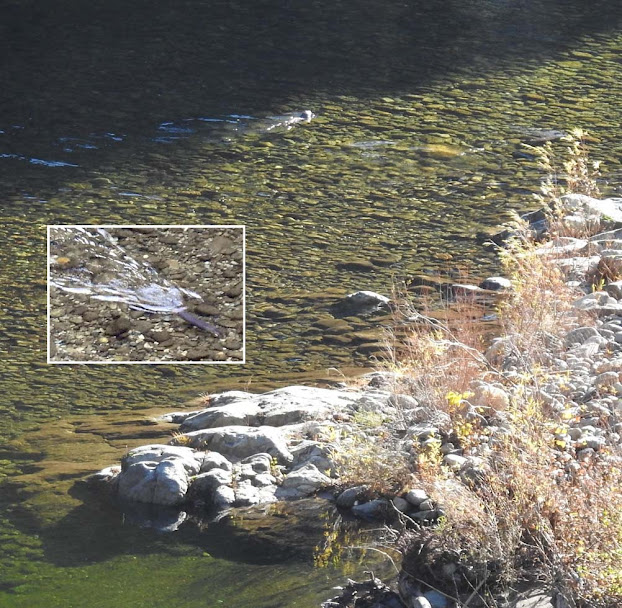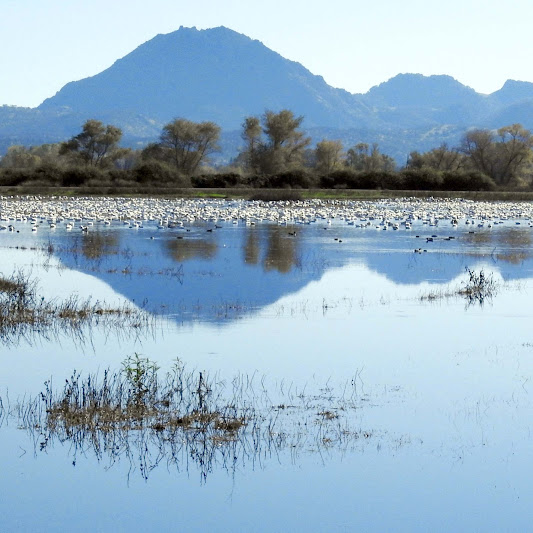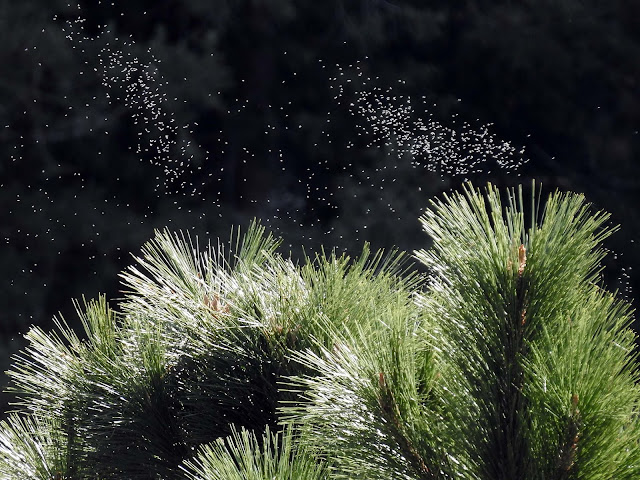Western Polypody & Dendroalsia Moss
Polypodium hesperium - Dendroalsia albietina
With no wildflowers to distract me, I've been focusing on our local ferns, which have been flourishing in the recent rains. Last winter I mentioned that ferns have a diploid/haploid alternation of generations, but I didn't really explain how that works. This year I decided to do some more research on that topic. Luckily I found the following website, https://www.thoughtco.com/fern-life-cycle-4158558, which is an amazing source of information about ferns. The following quote from this website explains the fern life-cycle well, and thoroughly. I have edited it a little to simplify the information.
Giant Chain Fern sori that contain spores - Woodwardia fimbriata
"The fern life cycle requires two generations of plants to complete itself. This is called "alternation of generations".
One generation is diploid, meaning it carries two identical sets of chromosomes in each cell or the full genetic complement (like a human cell). The leafy fern with spores is part of the diploid generation, called the sporophyte.
A fern's spores don't grow into leafy sporophyte. They aren't like seeds of flowering plants. Instead, they produce a haploid generation. In a haploid plant, each cell contains one set of chromosomes or half the genetic complement (like a human sperm or egg cell). This version of the plant looks like a little heart-shaped plantlet. It is called the prothallus or gametophyte.
The Fern Life Cycle
Starting with the "fern" as we recognize it (the sporophyte),
the life cycle follows these steps:
1)The diploid sporophyte produces haploid spores.
2)Each spore grows into a photosynthetic prothallus (gametophyte).
This plantlet is much smaller than the sporophyte fern.
3)Each prothallus produces gametes. Sperm is produced within a structure called an antheridium. The egg is produced within a similar structure called an archegonium. When water is present, sperm use their flagella to swim to an egg and fertilize it.
4)The fertilized egg remains attached to the prothallus. The egg is a diploid zygote formed by the combination of DNA from the egg and sperm. The zygote grows into the diploid sporophyte, completing the life cycle.
Before scientists understood genetics, fern reproduction was mystifying. It appeared as though adult ferns arose from spores. In a sense, this is true, but the tiny plantlets that emerge from spores are genetically different from adult ferns.
Fern life cycle - mariaflaya/Getty Images
Other Ways Ferns Reproduce
The fern "life cycle" refers to sexual reproduction. However, ferns use asexual methods to reproduce, too.
In apogamy, a sporophyte grows into a gametophyte without fertilization occurring. Ferns use this method of reproduction when conditions are too dry to permit fertilization.
Ferns can produce baby ferns at proliferous frond tips. As the baby fern grows, its weight causes the frond to droop toward the ground. Once the baby fern roots itself, it can survive separate from the parent plant. The proliferous baby plant is genetically identical to its parent. Ferns use this as a method of quick reproduction.
The rhizomes (fibrous structures that resemble roots) can spread through soil, sprouting new ferns. Ferns grown from rhizomes are also identical to their parents. This is another method that permits quick reproduction."
Liverworts - division Marchantiophyta
Armed with the knowledge of the fern life-cycle, I went in search of the haploid gametophytes this week. There's a mossy wet bank in our neighborhood that has lots of ferns growing on it. I examined the bank carefully, and in some damp, recessed, rock shelves I thought I found some gametophytes. They were tiny, about half the size of my little fingernail. I've since asked my friend who is a botanist to identify them, and she said that they were liverworts, not fern gametophytes. So I'll keep looking and maybe I'll get lucky!
Lace Fern & Dendroalsia Moss
Myriopteris gracillima - Dendroalsia albietina
I've also decided to learn the names of all the local ferns. Here's a photo gallery of some of the ones I've learned. The Lace Fern pictured above is easily distinguished by its finely divided fronds with lots of small pinnae (leaflets), and orange hairs on the underside of the fronds.
Giant Chain Fern - Woodwardia fimbriata
The Giant Chain Fern is easily distinguished by its three-foot-long fern fronds!
Western Polypody - Polypodium hesperium
I think lots of these Western Polypody Ferns just sprouted this past fall, when the rains came. I'll have to watch them through the year and see if they die off in the heat of the summer. I need to be more observant!
Five-finger Fern - Adiantum aleuticum
These delicate Five-finger Ferns die back in the Winter and re-grow in the Spring.
Snow Geese - Anser caerulescens
Gray Lodge Wildlife Area
The day after Thanksgiving, my husband and I made our annual drive down to the Gray Lodge Wildlife Area in California's Central Valley. It's always a joy to visit this refuge! We walked for hours through the reserve, enjoying the countless waterfowl, shorebirds, songbirds, and raptors that inhabit Gray Lodge in the winter! As in years past, there were thousands of Snow Geese arriving from the arctic, circling around and landing in the refuge, one of the most beautiful sights I've ever seen!
I've written about Gray Lodge in many previous blogs. Just enter "Gray Lodge" in the "search this blog" bar on the top right for more information and photos.
Northern Mockingbird - California Scrub Jay - Golden-crowned Sparrow
Mimus polyglottos - Aphelocoma californica - Zonotrichia atricapilla
In addition to the wetlands, the refuge has many shrubs and Cottonwood trees that birds perch in and inhabit.
Snow Geese - Anser caerulescens
At certain angles the Snow Geese almost disappear from view!
Black-necked Stilt - Northern Shoveler - Greater White-fronted Goose
Himantopus mexicanus - Anas clypeata - Anser albifrons
The shorebirds and waterfowl, besides the Snow Geese, are also numerous and beautiful to watch!
Snow Geese - Anser caerulescens
I never tire of watching and hearing the hundreds of Snow Geese arrive at the refuge!
Raindrops on bare Maple branches
Damp Earth Art
We received .69" of rain over the past week! Yay! Heavy rain and snow is predicted for the coming week! My fingers are crossed that we get lots of precipitation! In the meantime, I'm continuing my constant hope for rain (or snow!). Please join me! Perhaps our collective efforts may help it happen. I'm going to keep posting rain inspired writings, art, etc. on my blog at dampearthart.blogspot.com. Any submissions would be greatly appreciated. In the meantime pray/wish/hope/dance for rain!
Is there any Fall color left?
What's happening on the river?
What mammals are around?
Check back next week for the answers to these questions and more.
Unfortunately, you can no longer sign up to get my blog via email. Just go to northyubanaturalist.blogspot.com directly. It looks better than the emailed version!
Your questions and comments are greatly appreciated. Please feel free to email me at northyubanaturalist@gmail.com. Thanks!
























































